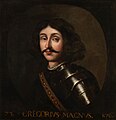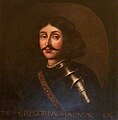Íomhá:Gregorius the Great or Giric of Scotland.jpg

Size of this preview: 578 × 600 picteilín. Other resolutions: 231 × 240 picteilín | 462 × 480 picteilín | 740 × 768 picteilín | 987 × 1,024 picteilín | 2,168 × 2,250 picteilín.
Taispeáin leagan ardtaifigh den íomhá (2,168 × 2,250 picteilín, méid comhaid: 738 KB, cineál MIME: image/jpeg)
Stair chomhaid
Cliceáil ar dáta/am chun an comhad a radharc mar a bhí sé ag an am sin.
| Dáta/Am | Mionsamhail | Toisí | Úsáideoir | Nóta tráchta | |
|---|---|---|---|---|---|
| faoi láthair | 07:25, 23 Meán Fómhair 2023 |  | 2,168 × 2,250 (738 KB) | Flag Creator | a bit better |
| 19:38, 17 Iúil 2017 |  | 1,101 × 1,121 (461 KB) | Millergeorge253 | User created page with UploadWizard |
Úsáid comhaid
Tá nasc chuig an gcomhad seo ar na leathanaigh seo a leanas:
Global file usage
The following other wikis use this file:
- Úsáid ar af.wikipedia.org
- Úsáid ar ar.wikipedia.org
- Úsáid ar arz.wikipedia.org
- Úsáid ar be.wikipedia.org
- Úsáid ar ca.wikipedia.org
- Úsáid ar cs.wikipedia.org
- Úsáid ar da.wikipedia.org
- Úsáid ar el.wikipedia.org
- Úsáid ar en.wikipedia.org
- Úsáid ar eo.wikipedia.org
- Úsáid ar es.wikipedia.org
- Úsáid ar eu.wikipedia.org
- Úsáid ar fa.wikipedia.org
- Úsáid ar fr.wikipedia.org
- Úsáid ar gd.wikipedia.org
- Úsáid ar gl.wikipedia.org
- Úsáid ar hu.wikipedia.org
- Úsáid ar id.wikipedia.org
- Úsáid ar it.wikipedia.org
- Úsáid ar ka.wikipedia.org
- Úsáid ar ko.wikipedia.org
- Úsáid ar lt.wikipedia.org
- Úsáid ar lv.wikipedia.org
- Úsáid ar nl.wikipedia.org
- Úsáid ar no.wikipedia.org
- Úsáid ar ru.wikipedia.org
- Úsáid ar sr.wikipedia.org
- Úsáid ar www.wikidata.org
